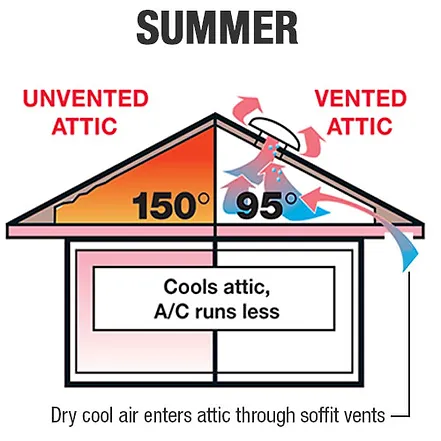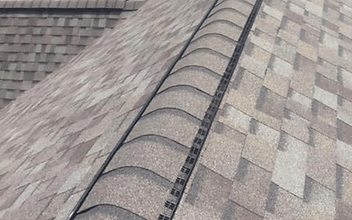When it comes to maintaining a comfortable and healthy living environment, there's one often overlooked aspect of home design that plays a crucial role – proper roof ventilation. While roofs are typically associated with providing shelter from the elements, their significance extends beyond that. In this blog, we'll delve into the importance of proper roof ventilation and how it contributes to a cooler, healthier, and more energy-efficient home.
The Basics of Roof Ventilation
Roof ventilation involves the movement of air within and around the attic or roof space. It serves two primary purposes: regulating temperature and preventing moisture buildup. A well-ventilated roof allows hot air to escape during the summer, keeping the attic cooler and reducing strain on your air conditioning system. In colder months, ventilation helps prevent condensation and moisture buildup, which can lead to mold, mildew, and even structural damage.
Benefits of Proper Roof Ventilation
-
Temperature Regulation:
In warmer seasons, attics can become stifling hot, reaching temperatures far higher than the outside air. Without proper ventilation, this trapped heat can seep into your living spaces, making your home uncomfortable and increasing cooling costs. Adequate roof ventilation expels hot air, ensuring your attic remains closer to the ambient temperature, and thus reducing the overall heat load on your home.
-
Energy Efficiency:
An overheated attic can force your air conditioner to work harder, leading to increased energy consumption and higher utility bills. With proper roof ventilation, your cooling system can operate more efficiently, resulting in potential energy savings. In fact, the Department of Energy estimates that a well-ventilated attic can reduce cooling costs by up to 10%.
-
Moisture Control:
Excess moisture in the attic can wreak havoc on your home's structural integrity and indoor air quality. Proper ventilation prevents moisture buildup by allowing humid air to escape, reducing the risk of mold and mildew growth. This is particularly crucial in regions prone to heavy rainfall or snowfall.
-
Extended Roof Lifespan:
Excessive heat and moisture can deteriorate roofing materials over time. By maintaining a well-ventilated attic, you can help extend the lifespan of your roof, saving you money on premature repairs or replacements.
-
Indoor Air Quality:
Airborne pollutants and volatile organic compounds (VOCs) can accumulate in poorly ventilated spaces, leading to poor indoor air quality. An effectively ventilated attic helps expel these pollutants, contributing to a healthier living environment.
-
Ice Dam Prevention:
In colder climates, ice dams can form on roofs due to the uneven melting and refreezing of snow. Proper ventilation helps regulate the attic temperature, reducing the likelihood of ice dams forming and the subsequent water damage they can cause.
Types of Roof Ventilation
There are various roof ventilation options available, each catering to different types of roofs and climates. Some common types include:
1. Ridge Vents: Installed along the peak of the roof, these vents allow hot air to escape while preventing rain and snow from entering.
2. Soffit Vents: Placed in the eaves or soffits, these vents allow cool, fresh air to enter the attic, promoting air circulation.
3. Gable Vents: Located on the sides of the roof, these vents facilitate air exchange and are effective when used in combination with other ventilation systems.
4. Turbine Vents: These wind-driven vents create a vacuum effect, expelling hot air as wind passes over them.
5. Powered Attic Fans: Electrically powered fans help enhance airflow and are particularly useful in areas with limited natural ventilation.
Proper roof ventilation is far more than just an architectural afterthought; it's a fundamental aspect of maintaining a comfortable, energy-efficient, and healthy home. By ensuring adequate air circulation, you can regulate temperature, prevent moisture-related issues, and prolong the lifespan of your roof. Whether you're constructing a new home or considering improvements to your current one, don't underestimate the vital role that proper roof ventilation plays in creating a harmonious living environment.


